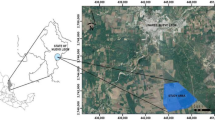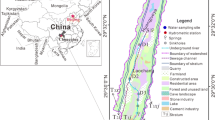Abstract
Monitored natural attenuation (MNA) technology is a groundwater remediation method that relies on risk management and long-term monitoring. However, there are currently few studies that have investigated the effectiveness of natural attenuation as a remediation method for carbon tetrachloride-contaminated sites. The objective of this study is to quantify the natural attenuation of tetrachloride contamination in a polluted site in eastern China through a 2-year MNA. Carbon tetrachloride was found to be the most severely pollutant in the saturated aquifers of the site, with a range of 76,696 m2 (> 0.5 mg L−1). Results show that the concentration in the deep quaternary first aquifer (QFA) was higher than that in the shallow aquifer. The maximum concentration at the center of the pollution plume in the bedrock aquifer (BA) was reduced from the initial 35.3 to 10.7 mg L−1 after the implementation of MNA. The hypothesis that carbon tetrachloride was affected by the stratum fluctuation was verified through the field investigations. Specifically, the concentration of carbon tetrachloride decreased as the elevation of the monitoring point increased in the same aquifer generally. It was notable that the highly weathered bedrock fractured aquifer provided a large amount of relatively evenly fractured space for pollutant storage. Moreover, the heterogeneity of fracture network distribution also led to the appearance of the delamination characteristics of carbon tetrachloride. The diffusion of the carbon tetrachloride plume was mainly influenced with hydrodynamics and topographical fluctuations. The maximum concentration of carbon tetrachloride decreased with a rate of 48.84% in deep QFA, whereas it decreased with a rate of 69.69% in BA. The present study holds significant importance for the remediation of sites contaminated with DNAPL (dense non-aqueous phase liquid). Furthermore, the study can also help in identifying the key factors that influence the natural attenuation process and aid in developing effective remediation strategies for DNAPL-contaminated sites.








Similar content being viewed by others
Data Availability
The datasets generated during and/or analyzed during the current study are available from the corresponding author on reasonable request.
References
Amin, M. M., Khanahmad, H., Teimouri, F., Sadani, M., Karami, M. A., & Hatamzadeh, M. (2017). Effect of monorhamnolipid contribution on anaerobic-natural attenuation of explosives in contaminated soils. Journal of Environmental Engineering, 143(8), 04017035. https://doi.org/10.1061/(asce)ee.1943-7870.0001227
Baker, R. S., Nielsen, S. G., Heron, G., & Ploug, N. (2016). How effective is thermal remediation of DNAPL source zones in reducing groundwater concentrations? Groundwater Monitoring and Remediation, 36(1), 38–53. https://doi.org/10.1111/gwmr.12149
Banejad, H., Mohebzadeh, H., Ghobadi, M. H., & Heydari, M. (2014). Numerical simulation of groundwater flow and contamination transport in Nahavand plain aquifer, west of Iran. Journal of the Geological Society of India, 83(1), 83–92. https://doi.org/10.1007/s12594-014-0010-9
Barker, J. P., Patrick, G. C., & Major, D. (1987). Natural attenuation of aromatic hydrocarbons in a shallow sand aquifer. Ground Water Monitoring & Remediation, 7, 64–71. https://doi.org/10.1111/j.1745-6592.1987.tb01063.x
Chaíneau, C. H., Morel, J. L., & Oudot, J. (1995). Microbial degradation in soil microcosms of fuel oil hydrocarbons from drilling cuttings. Environmental Science and Technology, 29(6), 1615–1621. https://doi.org/10.1021/es00006a027
Clement, T. P., Truex, M. J., & Lee, P. (2002). A case study for demonstrating the application of U.S. EPA’s monitored natural attenuation screening protocol at a hazardous waste site. Journal of Contaminant Hydrology, 59(1–2), 133–162. https://doi.org/10.1016/S0169-7722(02)00079-7
Davis, L. C., & Erickson, L. E. (2004). A review of bioremediation and natural attenuation of MTBE. Environmental Progress. https://doi.org/10.1002/ep.10028
Declercq, I., Cappuyns, V., & Duclos, Y. (2012). Monitored natural attenuation (MNA) of contaminated soils: State of the art in Europe — A critical evaluation. Science of the Total Environment, the, 426, 393–405. https://doi.org/10.1016/j.scitotenv.2012.03.040
Eziz, M., Sidikjan, N., Zhong, Q., Rixit, A., & Li, X. (2023). Distribution, pollution levels, and health risk assessment of heavy metals in groundwater in the main pepper production area of China. Open Geosciences, 15(1), 250–264. https://doi.org/10.1515/geo-2022-0491
Fagerlund, F., Illangasekare, T. H., Phenrat, T., Kim, H. J., & Lowry, G. V. (2012). PCE dissolution and simultaneous dechlorination by nanoscale zero-valent iron particles in a DNAPL source zone. Journal of Contaminant Hydrology, 131(1–4), 9–28. https://doi.org/10.1016/j.jconhyd.2011.08.011
Gádara, M. J. F., Perreira, R. A. L., Devesa, A. A., Bermejo, F., Gádara, M. J. F., Perreira, R. A. L., et al. (1992). Occurrence of halogenated hydrocarbons in the water supply of ifferent cities of alicia (Spain). Environmental Technology, 13(5), 437–447. https://doi.org/10.1080/09593339209385171
Gao, Y., Ji, W., & Li, T. (2023). A case study of deep DNAPL contamination in marine soft clays. Geofluids, 2023, 1–11. https://doi.org/10.1155/2023/5059543
Grandel, S., & Dahmke, A. (2004). Monitored natural attenuation of chlorinated solvents: Assessment of potential and limitations. Biodegradation. https://doi.org/10.1023/B:BIOD.0000044683.44549.99
Gundogar, A. S., Ross, C. M., Jew, A. D., Bargar, J. R., & Kovscek, A. R. (2021). Multiphysics investigation of geochemical alterations in Marcellus shale using reactive core floods. Energy & Fuels, 35(13), 33–45. https://doi.org/10.1021/acs.energyfuels.1c00588
Habiyakare, T., Zhang, N., Feng, C. H., Ndayisenga, F., Kayiranga, A., Sindikubwabo, C., Muhirwa, F., & Shah, S. (2022). The implementation of genetic algorithm for the identification of DNAPL sources. Groundwater for Sustainable Development, 16, 1–10. https://doi.org/10.1016/j.gsd.2021.100707
Jawitz, J. W., Sillan, R. K., Annable, M. D., Rao, P. S. C., & Warner, K. (2000). In-situ alcohol flushing of a DNAPL source zone at a dry cleaner site. Environmental Science and Technology, 34(17), 3722–3729. https://doi.org/10.1021/es9913737
Ji, S.-H., Yeo, I. W., Lee, K.-K., & Glass, R. J. (2003). Influence of ambient groundwater flow on DNAPL migration in a fracture network: Experiments and simulations. Geophysical Research Letters, 30(10), n/a-n/a. https://doi.org/10.1029/2003gl017064
Kao, C. M., Huang, W. Y., Chang, L. J., Chen, T. Y., Chien, H. Y., & Hou, F. (2006). Application of monitored natural attenuation to remediate a petroleum-hydrocarbon spill site. Water Science and Technology, 53(2), 321–328. https://doi.org/10.2166/wst.2006.066
Karges, U., Becker, J., & Püttmann, W. (2018). 1,4-Dioxane pollution at contaminated groundwater sites in western Germany and its distribution within a TCE plume. Science of the Total Environment, 619–620, 712–720. https://doi.org/10.1016/j.scitotenv.2017.11.043
Kohli, P., Richnow, H. H., & Lal, R. (2017). Compound-specific stable isotope analysis: Implications in hexachlorocyclohexane in-vitro and field assessment. Indian Journal of Microbiology, 57(1), 11–22. https://doi.org/10.1007/s12088-016-0630-4
Kong, J., Shen, C. J., Xin, P., Song, Z., Li, L., Barry, D. A., et al. (2013). Capillary effect on water table fluctuations in unconfined aquifers. Water Resources Research, 49(5), 3064–3069. https://doi.org/10.1002/wrcr.20237
Lee, K. Y., & Chrysikopoulos, C. V. (2006). Dissolution of a multicomponent DNAPL pool in an experimental aquifer. Journal of Hazardous Materials, 128(2–3), 218–226. https://doi.org/10.1016/j.jhazmat.2005.08.005
Lookman, R., Verbeeck, M., Gemoets, J., Van Roy, S., Crynen, J., & Lambié, B. (2013). In-situ zinc bioprecipitation by organic substrate injection in a high-flow, poorly reduced aquifer. Journal of Contaminant Hydrology, 150, 25–34. https://doi.org/10.1016/j.jconhyd.2013.03.009
Madsen, E. L. (1991). Determining in situ biodegradation. Environmental Science and Technology, 25(10), 1662–1673. https://doi.org/10.1021/es00022a001
Madsen, E. L. (1998). Epistemology of environmental microbiology. Environmental Science and Technology, 32(4), 429–439. https://doi.org/10.1021/es970551y
Neuhauser, E. F., Ripp, J. A., Azzolina, N. A., Madsen, E. L., Mauro, D. M., & Taylor, T. (2009). Monitored natural attenuation of manufactured gas plant tar mono- and polycyclic aromatic hydrocarbons in ground water: A 14-year field study. Ground Water Monitoring and Remediation, 29(3), 66–76. https://doi.org/10.1111/j.1745-6592.2009.01244.x
Newell, C. J., Adamson, D. T., Kulkarni, P. R., & Nzeribe, B. N. (2021). Monitored attenuation to manage PFAS impacts to groundwater: Scientific basis. Groundwater Monitoring & Remediation, 41(4), 76–89. https://doi.org/10.1111/gwmr.12486
Noel, V., Druhan, J. L., Gundogar, A., Kovscek, A. R., Brown, G. E., & Bargar, J. R. (2023). Dynamic development of geochemical reaction fronts during hydraulic stimulation of shale. Applied Geochemistry: Journal of the International Association of Geochemistry and Cosmochemistry, 148, 1–10. https://doi.org/10.1016/j.apgeochem.2022.105542
Obiri-nyarko, F., Grajales-mesa, S. J., & Malina, G. (2014). An overview of permeable reactive barriers for in situ sustainable groundwater remediation. Chemosphere, 111, 243–259. https://doi.org/10.1016/j.chemosphere.2014.03.112
Pan, Y., Zeng, X., Xu, H., Sun, Y., Wang, D., & Wu, J. (2020). Assessing human health risk of groundwater DNAPL contamination by quantifying the model structure uncertainty. Journal of Hydrology, 584(February), 124690. https://doi.org/10.1016/j.jhydrol.2020.124690
Quinn, J., Geiger, C., Clausen, C., Brooks, K., Coon, C., O’Hara, S., et al. (2005). Field demonstration of DNAPL dehalogenation using emulsified zero-valent iron. Environmental Science and Technology, 39(5), 1309–1318. https://doi.org/10.1021/es0490018
Rivett, M. O., & Allen-King, R. M. (2003). A controlled field experiment on groundwater contamination by a multicomponent DNAPL: Dissolved-plume retardation. Journal of Contaminant Hydrology, 66(1–2), 117–146. https://doi.org/10.1016/S0169-7722(03)00006-8
Rivett, M. O., Feenstra, S., & Cherry, J. A. (2001). A controlled field experiment on groundwater contamination by a multicomponent DNAPL: Creation of the emplaced-source and overview of dissolved plume development. Journal of Contaminant Hydrology, 49(1–2), 111–149. https://doi.org/10.1016/S0169-7722(00)00191-1
Stewart, M., & North, L. (2006). A borehole geophysical method for detection and quantification of dense, non-aqueous phase liquids (DNAPL) in saturated soils. Journal of Applied Geophysics, 60(2), 87–99. https://doi.org/10.1016/j.jappgeo.2005.12.004
Su, C., Puls, R. W., Krug, T. A., Watling, M. T., O’Hara, S. K., Quinn, J. W., & Ruiz, N. E. (2012). A two and half-year-performance evaluation of a field test on treatment of source zone tetrachloroethene and its chlorinated daughter products using emulsified zero valent iron nanoparticles. Water Research, 46(16), 5071–5084. https://doi.org/10.1016/j.watres.2012.06.051
Wilson, K., Sewell, G., Kean, J. A., & Vangelas, K. (2007). Enhanced attenuation: Its place in the remediation of chlorinated solvents. Remediation, 17(2), 39–49. https://doi.org/10.1002/rem.20123
Wong, Y. J., Shimizu, Y., He, K., & Nik Sulaiman, N. M. (2020). Comparison among different ASEAN water quality indices for the assessment of the spatial variation of surface water quality in the Selangor river basin, Malaysia. Environmental Monitoring and Assessment, 192(10). https://doi.org/10.1007/s10661-020-08543-4
Wong, Y. J., Shimizu, Y., Kamiya, A., Maneechot, L., Bharambe, K. P., Fong, C. S., & Nik Sulaiman, N. M. (2021). Application of artificial intelligence methods for monsoonal river classification in Selangor river basin, Malaysia. Environmental Monitoring and Assessment, 193(7). https://doi.org/10.1007/s10661-021-09202-y
Wu, J., Zhu, S., Zhu, Z., Lu, B., & Wang, L. (2023). Experimental study on residual and dissolution of DNAPL in transparent fracture. Geofluids, 2023, 1–12. https://doi.org/10.1155/2023/4208655
Yang, J. H., Jun, S. C., Kwon, H. P., & Lee, K. K. (2014). Tracing of residual multiple DNAPL sources in the subsurface using 222Rn as a natural tracer at an industrial complex in Wonju, Korea. Environmental Earth Sciences, 71(1), 407–417. https://doi.org/10.1007/s12665-013-2448-2
Yeh, C. K. J., Wu, H. M., & Chen, T. C. (2003). Chemical oxidation of chlorinated non-aqueous phase liquid by hydrogen peroxide in natural sand systems. Journal of Hazardous Materials, 96(1), 29–51. https://doi.org/10.1016/S0304-3894(02)00147-4
Zhu, X., Han, B., & Feng, Q. (2020). Common anions affected removal of carbon tetrachloride in groundwater using granular sponge zerovalent iron. Water, Air, and Soil Pollution, 231(4). https://doi.org/10.1007/s11270-020-04494-1
Funding
This work was supported by the National Natural Science Foundation of China (No. 42107015).
Author information
Authors and Affiliations
Corresponding author
Ethics declarations
Competing Interests
The authors declare no competing interests.
Additional information
Publisher's Note
Springer Nature remains neutral with regard to jurisdictional claims in published maps and institutional affiliations.
Rights and permissions
Springer Nature or its licensor (e.g. a society or other partner) holds exclusive rights to this article under a publishing agreement with the author(s) or other rightsholder(s); author self-archiving of the accepted manuscript version of this article is solely governed by the terms of such publishing agreement and applicable law.
About this article
Cite this article
Wei, Y., Liu, W., Liu, L. et al. Quantitative Assessment of Monitoring Natural Attenuation on Carbon Tetrachloride Reduction at a Groundwater-Contaminated Site in Eastern China. Water Air Soil Pollut 234, 647 (2023). https://doi.org/10.1007/s11270-023-06598-w
Received:
Accepted:
Published:
DOI: https://doi.org/10.1007/s11270-023-06598-w




